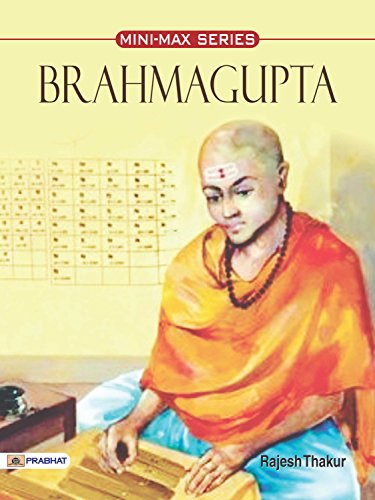. Brahmagupta was born in 598 CE according to his statement.
. He lived in Bhillamala in Gurjaradesa (modern Bhinmal in Rajasthan, India) during the reign of the Chavda dynasty ruler, Vyagrahamukha.
. His father Jisnugupta was an Astrologer in the city of Bhinmal (Rajasthan).
. He was a Hindu by religion, in particular, a Shaivite.
. He lived and worked there for a good part of his life.
Education
. Bhillamala was the capital of the Gurjaradesa, the second-largest kingdom of Western India, comprising southern Rajasthan and northern Gujarat in modern-day India.
. It was also a centre of learning for mathematics and astronomy.
. Brahmagupta became an astronomer of the Brahmapaksha school, one of the four major schools of Indian astronomy during this period.
• He studied the five traditional Siddhantas on Indian astronomy as well as the work of other astronomers including Aryabhata I, Latadeva, Pradyumna, Varahamihira, Simha, Srisena, Vijayanandin and Vishnuchandra.
Work & Book
. Brahmagupta was the first to give a rule to compute with zero
. Brahmasphutasiddhanta was composed in 628 CE.
. Khandakhadyaka, composed in 665 CE.
. Grahanarkajnana, (ascribed in one manuscript ).
Brahma sphuta siddhanta
. In the year 628, at the age of 30, he composed the Brahmasphutasiddhanta (“Improved treatise of Brahma”) which is believed to be a revised version of the received Siddhanta of the Brahmapaksha school of astronomy.
. Scholars state that he incorporated a great deal of originality into his revision, adding a considerable amount of new material.
. The book consists of 24 chapters with 1008 verses in the arya metre.
A good deal of it is astronomy, but it also contains key chapters on mathematics, including algebra, geometry, trigonometry and algorithmics, which are believed to contain new insights due to Brahmagupta himself .
Khandakhadyaka
. Later, Brahmagupta moved to Ujjaini , Avanti , which was also a major centre for astronomy in central India .
. At the age of 67, he composed his next well- known work khanda-kayak, a practical manual of Indian astronomy in the karana category meant to be used by students.
Earth
. The length of a year is 365 days 6 hours 12 minutes 9 seconds which is very close to today’s calculation.
. Brahmagupta talked about ‘gravity.’
. To quote him, ‘Bodies fall towards the earth as it is like the earth to attract bodies, just as it is in the nature water to flow.’
. Proved that the Earth is a sphere and calculated its circumference to be around 36,000 km (modern 40,075 km).
Brahmagupta gave the first rules for dealing with zero as a number…
When zero is added to a number or subtracted from a number, the number remains unchanged.
A number multiplied by zero becomes zero.
…and for dealing with positive (fortune) and negative (debt) numbers.
ZERO
. Brahmagupta established the basic mathematical rules for dealing with zero (1+0=1; 1-0=1; and 1 x 0 = 0), although his understanding of division by zero was incomplete (he thought that 1 + 0 = 0).
. Almost 500 years later, in the 12th Century, another Indian mathematician, Bhaskara II, showed that the answer should be infinity, not zero (because it can be divided into an infinite number of pieces of size zero), an answer that was considered correct for centuries.
. However, this logic does not explain why 20,70, etc, should also be zero – the modern view is that a number divided by zero is actually “undefined” (i.e. it doesn’t make sense).
Brahmagupta’s theorem

. He continues to give formulas for the lengths and areas of geometric figures, such as the circumradius of an isosceles trapezoid and a scalene quadrilateral, and the lengths of diagonals in a scalene cyclic quadrilateral. This leads up to Brahmagupta’s famous theorem .
Theorem 110 (Brahmagupta’s Formula)

Acyclic Quadrilateral = √(sa)(sb)(s – c)(s – d)
where a, b, c, and d are the lengths of the sides of the quadrilateral and
s = semiperimeter = a+b+c+d/2
Brahmagupta’s theorem
• In geometry, Brahmagupta’s theorem states that if a cyclic quadrilateral is orthodiagonal (that is, has perpendicular diagonals), then the perpendicular to a side from the point of intersection of the diagonals always bisects the opposite side.

Brahmagupta’s Work
. Brahmagupta dedicated a substantial portion of his work to geometry and trigonometry.
. He established √10 (3.162277) as a good practical approximation for ㅠ (3.141593) and gave a formula, 36 now known as Brahmagupta’s Formula, for the area of a cyclic quadrilateral.
Contributions:- Most critically acclaimed- Chakravala method!
Commentaries by foreign mathematicians on the Chakravala method:
“The method represents the best approximation algorithm of minimal length that, owing to several minimization properties, with minimal effort and avoiding large numbers automatically produces the best solutions to the equation.
The Chakravala method anticipated the European methods by more than a thousand years.
But no European performances in the whole field of algebra at a time much later than Bhaskara’s, nay nearly equal up to our times, equaled the marvelous complexity and ingenuity of Chakravala.
Selenium
“the finest thing achieved in the theory of numbers before Lagrange.”-Hermann Hankel
Death
Brahmagupta died in 668 CE, and he is presumed to have died in Ujjain.
He was honored by the title given to him by a fellow scientist “Ganita Chakra Chudamani” which is translated as ‘The gem of the circle of mathematicians.
